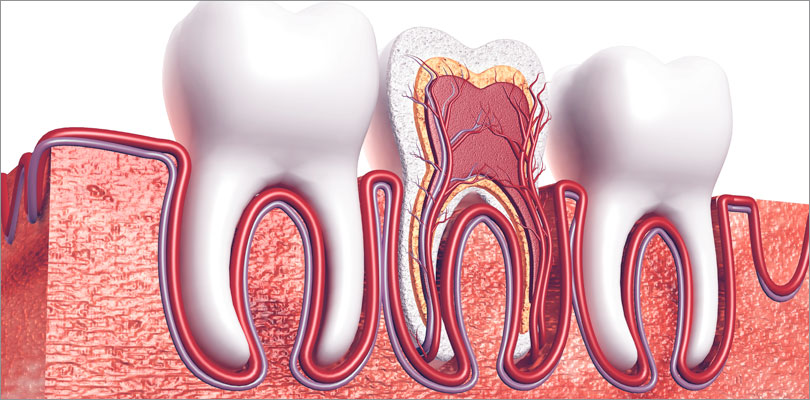Root Canal Therapy in North RD, Coquitlam

Many people may be familiar with the phrase “root canal”, but not everyone is aware of what it actually means. Root canal therapy is a procedure used to save teeth that have been damaged due to decay and infection. This procedure involves removing the pulp and nerve tissue from within the tooth and replacing it with a material called gutta-percha. Root canal therapy can be an intimidating thought - but don't worry! Here at Brookmere Dental, we do Root Canal Therapy in Coquitlam, we are here to make sure your experience is as comfortable as possible. Here we will discuss why root canal therapy may be necessary for you, as well as how our team can provide you with excellent care throughout the entire process.
What is root canal therapy?
Root canal therapy is an endodontic treatment used to save a tooth that has been badly damaged or infected. The procedure involves removing the damaged or infected pulp from the inside of the tooth and then sealing it off to prevent further damage.
Although root canal therapy can be a bit uncomfortable, it is usually successful in saving the tooth and allowing you to keep your natural smile. The procedure is usually performed over the course of one or two appointments, depending on the severity of the damage or infection.
If you think you may need root canal therapy, don't hesitate to contact Brookmere Dental. Our experienced team will work with you to determine if this is the best treatment option for your individual situation.
What to Expect
Root canal therapy is a treatment used to save teeth that have been damaged by decay or injury. The procedure involves removing the damaged tissue from inside the tooth and filling the space with a special material.
Most people who need root canal therapy do not experience any pain during the procedure. However, you may feel some pressure when the dentist is working on your tooth. After the procedure, your tooth may be sensitive for a short time. You can take over-the-counter pain medication to help with any discomfort.
It is normal for your tooth to feel different after root canal therapy. You may notice that it is slightly darker than your other teeth. This is because the blood supply to your tooth has been removed. Once your tooth has healed, you can have it restored with a crown or veneer to match your other teeth.
Symptoms of Root Canal
When you have a tooth that is severely decayed or has become infected, the nerve and blood supply to that tooth become compromised. This can lead to a lot of pain and discomfort. In order to save the tooth, your dentist may recommend root canal therapy.
Root canal therapy involves removing the damaged nerve and blood supply from the tooth. The tooth is then cleaned and sealed. This helps to eliminate the pain and restore the function of the tooth.
Root canal therapy can be performed in one or two visits, depending on the severity of the damage. You may experience some discomfort during the procedure, but this can be controlled with local anesthesia. Most people report feeling relief from their symptoms after root canal therapy.
After Root Canal Treatment
After root canal treatment, it is important to care for your teeth and gums. This includes brushing and flossing regularly and seeing your dentist for regular checkups. Root canal therapy can help save your tooth, and it is important to take care of it properly to ensure its longevity.
How to detect & its diagnosis
Root canals are necessary when the pulp (the soft tissue inside the tooth) becomes inflamed or infected. The inflammation or infection can be caused by a deep cavity, a cracked tooth, or trauma to the tooth. Once the pulp is damaged, it cannot heal itself. The only way to save the tooth is to remove the pulp and seal off the root canal.
In a root canal procedure first, the dentist will numb your tooth and the surrounding area. Then, he or she will make an opening in your tooth to access the pulp chamber and root canals. Next, the diseased pulp will be removed and the root canals will be cleaned and sealed. Finally, a filling or crown will be placed over the opening in your tooth.
There are a few signs that you may need a root canal:
- Severe pain when chewing or applying pressure to your tooth
- Prolonged sensitivity to hot or cold temperatures
- Discoloration of your tooth
- Swelling in your gums
Benefits of Root Canal Treatment
1. Saving a Damaged Tooth: Root canal treatment can save a tooth that has been damaged by decay or injury. By removing the damaged tissue and bacteria from inside the tooth, root canal therapy can help to preserve the remaining healthy tooth structure.
2.Preventing Further Damage: Root canal treatment can also prevent further damage to the tooth. If left untreated, decay or injury can cause the tooth to become infected, which can lead to more serious problems such as bone loss or abscesses.
3. Improve Your Smile: Root canal treatment can also improve your smile by restoring a damaged or discolored tooth to its natural appearance. After treatment, your dentist may recommend placing a crown over the treated tooth to protect it from future damage and improve its appearance.
If you are looking for root canal treatment in North Road, Coquitlam, contact Brookmere Dental Group today!
Contact us today
Contact us today to learn more about how Root Canal Therapy can save your tooth and relieve your pain. Our experienced dentists will answer all of your questions and help you decide if this treatment is right for you. We offer convenient appointment times and accept most dental insurance plans. Call us now to get started!
